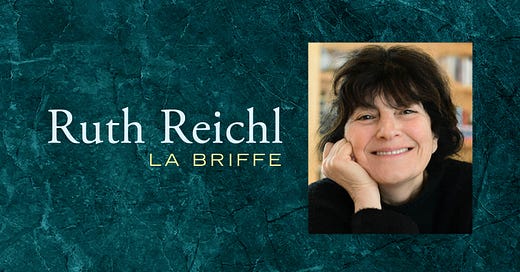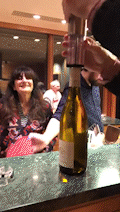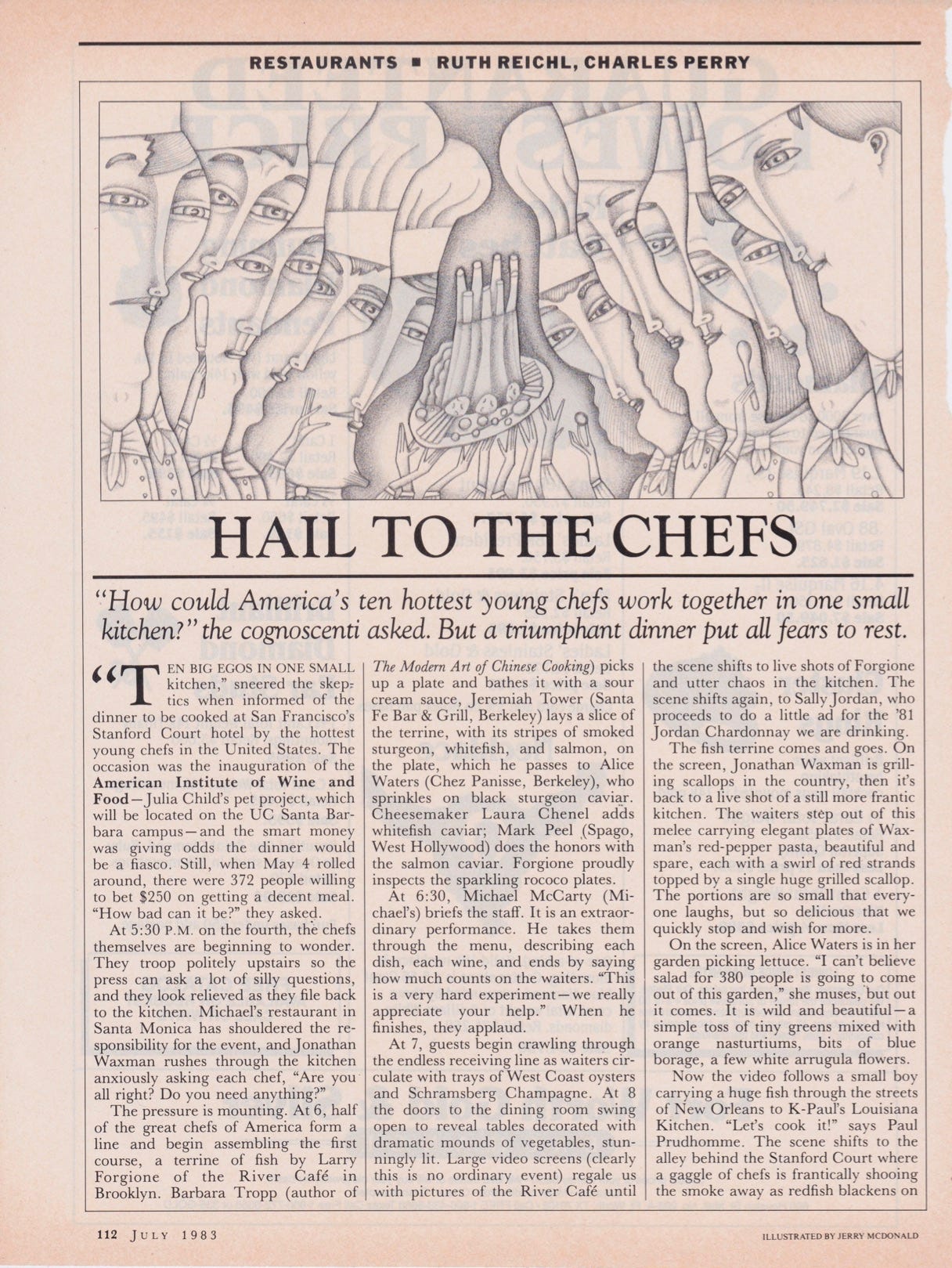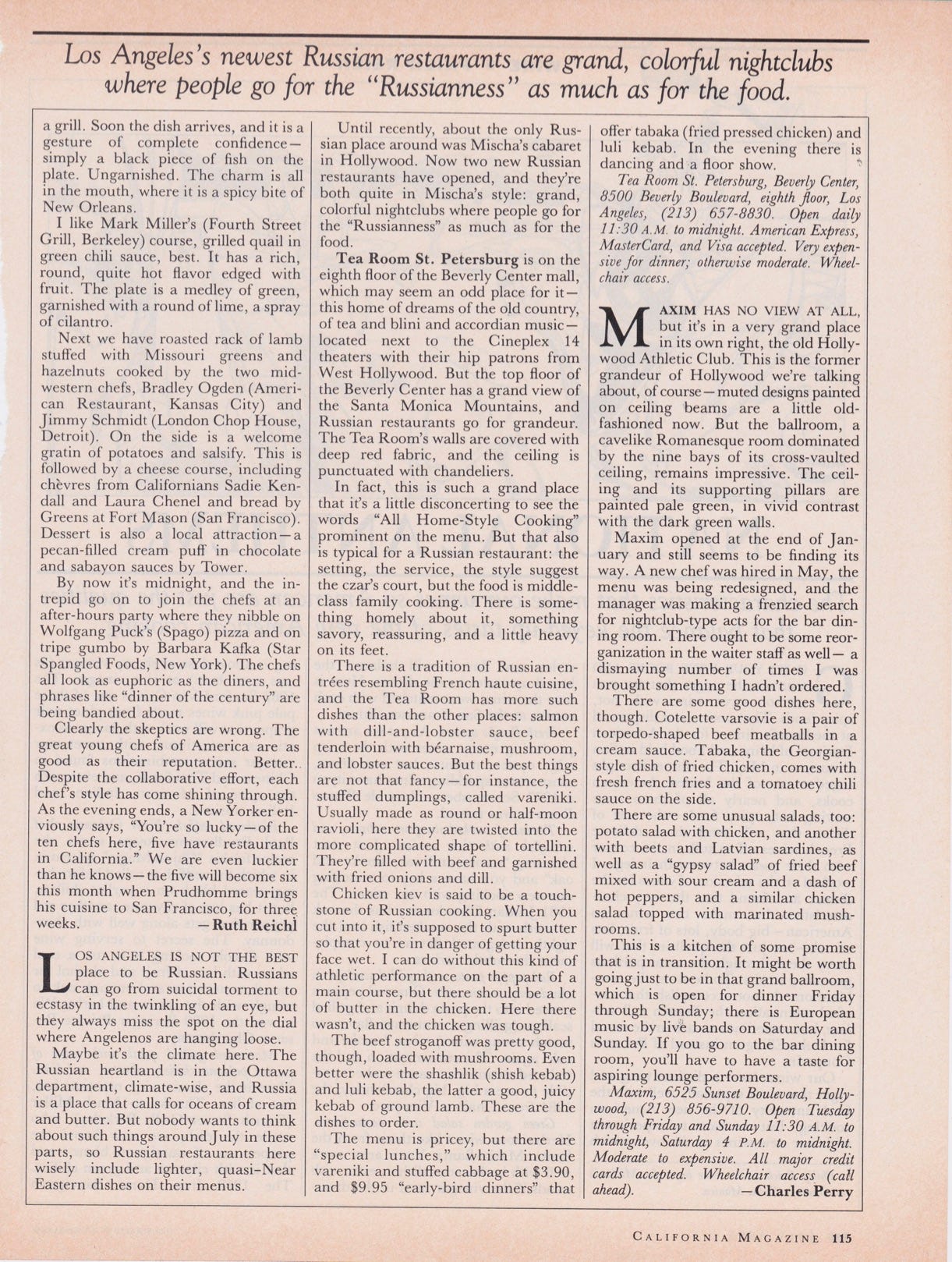When I told my parents I wanted to write about food they were horrified. So was almost everyone else I knew. Back then, few people in America gave a damn about what we ate or why we ate it.
I had no training — as a writer, a cook, or a recipe developer. I had no money and I knew no important people. All I had was a desire to cook and a deep interest in food (and the people who produce it). I had discovered, when I was very young, that you can learn a lot about people simply by watching what they eat. As I grew older I took a jaundiced look at what that was — squishy white bread, flavorless fruits and vegetables, antibiotic-laced meats — and knew we could do better. I thought that life in America would be much more rewarding if we paid closer attention to our appetites.
Fast forward fifty years. By following my passion, I had the enormous good luck to publish a couple of cookbooks, review restaurants for both The New York Times and the Los Angeles Times, and edit Gourmet Magazine. I produced a series of television shows, published books and cookbooks. And because the American food world was very small, I got to know a lot of fascinating people: Julia Child, MFK Fisher, James Beard, Cecilia Chiang…. It’s a long list.
But the truth is I still think America would be a better place if we all paid more attention to our food. That is why I’ve decided to spend the next month producing a mini-magazine here on Substack. There’s so much to talk about, and since December is a natural time to look at where we’ve been and where we’re going, that’s what I intend to do here.
In the eighties a chef looked at me as I stood in his kitchen and said, “You’re the Zelig of food. No matter where I am, there you are with a notepad writing it all down.” And, I’m one of those people who never throws anything away. Looking back at those early articles, I’m stunned by the picture they paint of the early days of the American food revolution. Many of the magazines I once wrote for no longer exist, and these articles have never been digitized. I’ll be sharing my archive with you, so that you can see what I was seeing. I’m going to include some of my reviews from the seventies and eighties, when Americans were falling in love with restaurants.
Another way to look into the past of American restaurants: the huge collection I’ve amassed of vintage menus. They paint remarkable portraits of their eras, and I’ll share those as well.
From there, let’s look at the present. Restaurant suggestions for places I’m loving. Recipes, of course.
I’m still in constant contact with chefs, farmers, fishermen and food producers across the country. I’ll be writing about what they consider the most important issues of the moment.
And then, the immediate present.
For the past ten years I’ve produced a daily gift guide every December. These are products I’ve bought with my own money and love telling people about. You may not be in the market for gifts, but these are new foods, utensils, cooking equipment, books and the like that will make any kitchen a happier place. And if I do say so myself, this year’s suggestions are particularly good.
Finally, I’m hoping to hear from you too, so I’ll be asking questions about what you’re eating, cooking and thinking. And answering any questions you care to send my way.
I’m calling this mini-magazine La Briffe, which is an affectionate old French term for food. (It also becomes a verb, briffer. And a person who loves food is a briffaud.) It will land in your in-box every day during December. And it is absolutely free.
Why am I doing this? Because as both a writer and an editor, I had a deep connection to my readers and I miss you. And because after all these years, I still think that we would be better off if we paid more attention to our food.
When a public relations person reached out to me last summer, insisting that she had the best wine opener ever, I was skeptical. I’ve gone through dozens at various price points, and with the exception of an antique beer opener, none has done better than the plain old waiter’s corkscrew.
Still, I had to give the Chefman Electric Wine Opener a try.
The first surprise was the price: under $20. The second was how pretty it is: plug it in and it begins to glow a lovely blue. (It keeps a charge through thirty bottles.) But the biggest surprise is how well it works. You simply put it on the bottle, press a button and the cork pretty much removes itself.
All my friends are getting one of these this year.
If you had told me, in 1983, that I’d still be talking about this dinner forty years later, I would have said you were insane. I should have known better.
It was, after all, the gala that kicked off Julia’ Child’s pet project, The American Institute of Wine and Food. Julia asked a group of the hottest chefs in America to cook together at San Francisco’s Stanford Court Hotel.
Everyone expected it to be a bust. In those days these kind of joint appearances simply weren’t done, and I think that every article about the event used the phrase “too many chefs.”
All I can say is that I’m very glad I was there.
You know how croutons are always disappointing, as if they're a consolation prize for the salad eater, or a way to rescue stale bread? Your salads deserve something better. Here it is — a crouton so delicious you may find yourself shredding vegetables simply as an excuse to eat more of them.
Start with a hunk of sourdough or some sturdy country bread instead of a baguette; you don’t want the crust, because it will not soak up the butter and oil mixture, which is what gives your croutons character.
Tear the bread into 1 1/2 inch pieces, which will give you a crouton with some heft.
Use a pan that is large enough to let you cook the bread in a single layer, which will allow you to really crisp your croutons.
Consider what flavors you want to infuse into your croutons. Garlic is great. So are herbes de provence, fresh basil, a little bit of cayenne - you know what flavors you’re craving.
Serve your croutons while they’re still warm. The contrast of toasty bread and cool greens is one of the things that makes a salad special.
Recipe
1 loaf sourdough or sturdy country bread
4 tablespoons butter
2 tablespoons olive oil
salt, pepper
aromatics: basil, garlic, cayenne
Shave the crust off the bread and tear it into 1 1/2 inch or so pieces; it should measure about 3 cups.
Melt the butter and olive oil in the saute pan with a pinch of salt and pepper. Add the aromatics and toss. Pour into a large bowl.
Toss the bread into the bowl with the butter mixture. Now give the bread a good squeeze, as if it were a sponge, so that soaks up all the liquid. It should feel soft and wet against your fingers.
Cook the dripping bread bits in the now dry pan, in a single layer over low heat, turning the pieces until they are a beautiful toasty gold and smell so delicious that they’re impossible to resist and you’re snatching them from the pan. Toss the crisp croutons right into salad, while they’re still warm, and rush the salad to the table.
Trumps was a former gas station that instantly became the hippest, most glamorous restaurant in Los Angeles when it opened in 1980. In a city that still thought fancy food had to be French, in a time when waiters still considered it a badge of honor to look down their noses at you, Trumps was a breath of fresh air. The room was understated, open, modern and filled with art by people like Ed Ruscha and Wayne Thibaud. But it was the food that was the real shocker.
The chef was Michael Roberts, a classical musician from Long Island, who did not believe in sacred cows. Just look at this menu! Michael’s most famous dish was guacamole made from frozen peas (it was fantastic), but he thought nothing of making a Monte Cristo sandwich with tuna, stuffing fried chicken with foie gras or serving a pasta pancake. And long before most people had heard of tapas, Michael was serving them.
Michael went on to open a restaurant with Kevin Costner, but sadly he had a congenital neurological disorder that first crippled and then killed him. He’s not as well-known as he deserves to be, but this smart, gentle incredibly funny man was a very important figure in the early days of California Cuisine. He had a wonderful palate and a fantastic spirit, and he was so far ahead of his time that I can’t help wondering what he’d be cooking today.
This article about Michael Roberts says a lot about both Michael and the food scene in LA in the early eighties.


















You are now my advent calendar.
Young food writer here! I am elated to read more about your story and learn from you through this series.